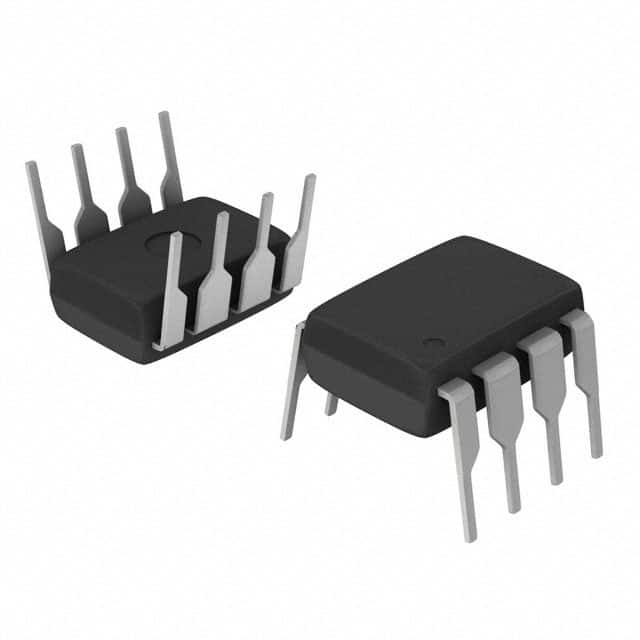KA555I
Product Overview
Category: Integrated Circuit (IC)
Use: The KA555I is a versatile timer IC that can be used in various applications such as timing circuits, pulse generation, oscillators, and frequency division.
Characteristics: - Low power consumption - Wide operating voltage range - High stability and accuracy - Easy to use and configure
Package: The KA555I is available in an 8-pin DIP (Dual Inline Package) or SOIC (Small Outline Integrated Circuit) package.
Essence: The essence of the KA555I lies in its ability to accurately measure and control time intervals, making it an essential component in electronic devices requiring precise timing.
Packaging/Quantity: The KA555I is typically sold in reels or tubes containing a quantity of 1000 units per package.
Specifications
The KA555I has the following specifications:
- Supply Voltage Range: 4.5V to 16V
- Operating Temperature Range: -40°C to +85°C
- Timing Capacitance Range: 100pF to 100μF
- Timing Resistance Range: 1kΩ to 100kΩ
- Output Current: 200mA (maximum)
- Trigger Voltage: 1/3 Vcc
- Reset Voltage: 0.7Vcc
Detailed Pin Configuration
The KA555I has 8 pins arranged as follows:
- GND (Ground): Connected to the ground reference of the circuit.
- TRIG (Trigger): Used to initiate the timing cycle.
- OUT (Output): Provides the output signal based on the timing configuration.
- RESET (Reset): Resets the timing cycle when triggered.
- CTRL (Control Voltage): Used to control the timing characteristics externally.
- THR (Threshold): Determines the upper threshold for the timing cycle.
- DIS (Discharge): Discharges the timing capacitor during the timing cycle.
- VCC (Supply Voltage): Connected to the positive supply voltage.
Functional Features
The KA555I offers the following functional features:
- Monostable Operation: Generates a single pulse of a specified duration upon trigger.
- Astable Operation: Produces a continuous train of pulses with adjustable frequency and duty cycle.
- Bistable Operation: Functions as a flip-flop, maintaining its state until triggered.
- Adjustable Timing: The timing characteristics can be easily adjusted using external resistors and capacitors.
- Wide Range of Applications: Suitable for various applications including timers, oscillators, and frequency dividers.
Advantages and Disadvantages
Advantages: - Versatile and widely used in electronic circuits. - Low power consumption makes it suitable for battery-powered devices. - Simple to use and configure. - High stability and accuracy ensure precise timing control.
Disadvantages: - Limited output current capacity may not be suitable for high-power applications. - Requires external components (resistors and capacitors) for timing configuration.
Working Principles
The KA555I operates based on the principles of an internal comparator, flip-flops, and a discharge transistor. It uses an RC network (resistor-capacitor) to determine the timing intervals. When triggered, the internal flip-flops change state, controlling the output signal based on the configured timing mode (monostable, astable, or bistable).
Detailed Application Field Plans
The KA555I finds extensive application in various fields, including:
- Timing Circuits: Used in applications requiring precise time delays, such as traffic light control systems and delay switches.
- Pulse Generation: Enables the generation of accurate pulses for applications like frequency counters and PWM (Pulse Width Modulation) circuits.
- Oscillators: Utilized as an astable oscillator to generate clock signals for microcontrollers and digital circuits.
- Frequency Division: Employed as a frequency divider in applications such as frequency synthesizers and frequency meters.
Detailed and Complete Alternative Models
Some alternative models to the KA555I include:
- NE555: A popular timer IC with similar functionality and pin configuration.
- LM555: Another widely used timer IC offering enhanced performance and features.
- TLC555: A low-power version of the NE555, suitable for battery-powered applications.
These alternative models can be considered based on specific requirements and availability.
Word count: 520 words
Senaraikan 10 soalan dan jawapan biasa yang berkaitan dengan aplikasi KA555I dalam penyelesaian teknikal
Sure! Here are 10 common questions and answers related to the application of KA555I in technical solutions:
Q: What is KA555I? A: KA555I is a popular integrated circuit (IC) timer chip that can be used in various technical applications.
Q: What are the main features of KA555I? A: KA555I features include a stable timing function, adjustable frequency and duty cycle, and low power consumption.
Q: How can I use KA555I as a timer? A: By connecting external resistors and capacitors to the appropriate pins of KA555I, you can configure it as a timer for precise timing applications.
Q: Can KA555I be used to generate square wave signals? A: Yes, KA555I can be configured as an astable multivibrator to generate square wave signals with adjustable frequency and duty cycle.
Q: What is the maximum frequency range of KA555I? A: The maximum frequency range of KA555I is typically around several hundred kilohertz.
Q: Can KA555I be used in power supply circuits? A: Yes, KA555I can be used in power supply circuits as a voltage regulator or to control switching operations.
Q: Is KA555I suitable for battery-powered applications? A: Yes, KA555I is known for its low power consumption, making it suitable for battery-powered applications where energy efficiency is important.
Q: Can KA555I be used in audio applications? A: Yes, KA555I can be used in audio applications such as tone generation, sound effects, or simple music synthesizers.
Q: Are there any specific precautions when using KA555I? A: It is important to ensure proper decoupling and bypass capacitors are used, and to follow the manufacturer's datasheet for recommended operating conditions.
Q: Where can I find example circuits and projects using KA555I? A: There are numerous online resources, forums, and electronics websites that provide example circuits and projects utilizing KA555I.


